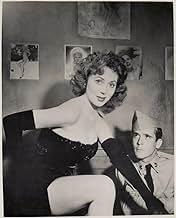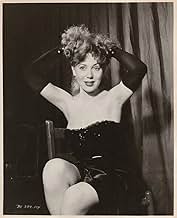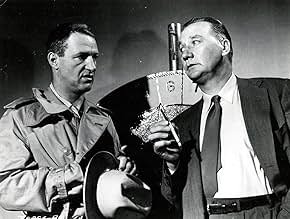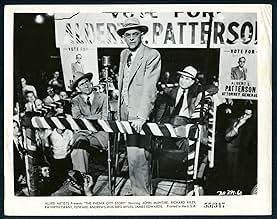NOTE IMDb
7,2/10
3,5 k
MA NOTE
Ajouter une intrigue dans votre langueA crime-busting lawyer and his initially reluctant attorney father take on the forces that run gambling and prostitution in their small Southern town.A crime-busting lawyer and his initially reluctant attorney father take on the forces that run gambling and prostitution in their small Southern town.A crime-busting lawyer and his initially reluctant attorney father take on the forces that run gambling and prostitution in their small Southern town.
- Réalisation
- Scénario
- Casting principal
- Récompenses
- 1 victoire et 1 nomination au total
Kathy Marlowe
- Mamie
- (as Katharine Marlowe)
Avis à la une
Whether your a fan of Noir or not, The Phenix City Story remains superior filmaking on all levels regardless of it's budget and lack of special effects. While some may laugh at substituting a doll briefly for a dead child; it's follow up scene continues to have as much shocking impact today as it did upon it's release. To say this is textbook noir filmaking is too small as by all standards The Phenix City Story is the barometer by which crime, realism, fistfights and expose cinema is measured up to.
Before the actual film begins, there is a 13-minute newsreel-style preface hosted by Clete Roberts in which he interviews the actual participants. Interestingly, this was done while the criminal cases discussed in the film were actually still being prosecuted.
This film is a film noir-like film that dramatizes the actual story about the town of Phenix, Alabama--a city run by gamblers and organized crime. It seems that in the 1940s and 50s, all kinds of vice was ignored by cops and city officials who were paid to look the other way. As a result, the soldiers in nearby Fort Benning were routinely cheated and had little, if any recourse. Eventually when local citizens tried to stand up for law and order, the mob resorted to threats and even murder to hold on to their power.
Unlike the typical film of the day, the scenes are quite brutal and violent. The only sour note is the scene of the child being tossed onto the lawn--it's obviously a dummy. There is also a lot of brutal and frank language--some of which might offend you, though it does lend the film an authentic sound. And, despite having mostly smaller caliber actors, they generally did very well. An odd note was having Richard Kiley of all people playing a tough action hero--he just wasn't the sort of guy you'd expect to see acting with his fists. Overall, this is an excellent low-budget film--well worth seeing.
The only question I have about all this is how much is true and how much was changed for the film? According to IMDb the Attorney General was not quite the saint you see in the film, but what about the other facts? I'd sure like to know more.
This film is a film noir-like film that dramatizes the actual story about the town of Phenix, Alabama--a city run by gamblers and organized crime. It seems that in the 1940s and 50s, all kinds of vice was ignored by cops and city officials who were paid to look the other way. As a result, the soldiers in nearby Fort Benning were routinely cheated and had little, if any recourse. Eventually when local citizens tried to stand up for law and order, the mob resorted to threats and even murder to hold on to their power.
Unlike the typical film of the day, the scenes are quite brutal and violent. The only sour note is the scene of the child being tossed onto the lawn--it's obviously a dummy. There is also a lot of brutal and frank language--some of which might offend you, though it does lend the film an authentic sound. And, despite having mostly smaller caliber actors, they generally did very well. An odd note was having Richard Kiley of all people playing a tough action hero--he just wasn't the sort of guy you'd expect to see acting with his fists. Overall, this is an excellent low-budget film--well worth seeing.
The only question I have about all this is how much is true and how much was changed for the film? According to IMDb the Attorney General was not quite the saint you see in the film, but what about the other facts? I'd sure like to know more.
Sometimes rush jobs really work out, like Phenix City Story. Consider that the movie was scripted, shot, and processed in less than a year after the triggering event of Patterson's murder. Credit the producers or someone for coming up with a first-rate cast, a marvelous director, and a big enough budget for location filming in the actual Phenix City. The result is the best of the "city expose" movies so popular at the time.
There's a rawness to the violence here that's more convincing than usual, in part because of director Karlson's "feel" for the material and also because it appears to grow organically out of the seedy surroundings of honky-tonks and carousing soldiers on leave from Fort Benning. Credit too the fine, underrated Edward Andrews for blending oily charm with ruthless violence, just the qualities needed to run an operation of that sort. Kiley too delivers in spades, his rage unusually intense and realistic. The only questionable note is Katherine Grant's Ellie, seemingly too sweet and naïve for a dealer in a crooked set-up.
Getting Karlson was a real coup. He was just hitting his stride as a top crime drama director during this period. His staging of the little girl's murder is a real grabber, along with the parking lot beating. In fact, the movie has an unusually pervasive atmosphere of unrestrained evil. Credit should also go to screenwriter Dan Mainwaring for a good tight script and some timely notes on the downside of vigilantism. Apparently, the lengthy prologue was added to ease censorship concerns, and, aside from historical value, can easily be skipped.
Anyway, the film's a must-see for B-movie fans, a happy coming together of a number of underrated Hollywood talents.
There's a rawness to the violence here that's more convincing than usual, in part because of director Karlson's "feel" for the material and also because it appears to grow organically out of the seedy surroundings of honky-tonks and carousing soldiers on leave from Fort Benning. Credit too the fine, underrated Edward Andrews for blending oily charm with ruthless violence, just the qualities needed to run an operation of that sort. Kiley too delivers in spades, his rage unusually intense and realistic. The only questionable note is Katherine Grant's Ellie, seemingly too sweet and naïve for a dealer in a crooked set-up.
Getting Karlson was a real coup. He was just hitting his stride as a top crime drama director during this period. His staging of the little girl's murder is a real grabber, along with the parking lot beating. In fact, the movie has an unusually pervasive atmosphere of unrestrained evil. Credit should also go to screenwriter Dan Mainwaring for a good tight script and some timely notes on the downside of vigilantism. Apparently, the lengthy prologue was added to ease censorship concerns, and, aside from historical value, can easily be skipped.
Anyway, the film's a must-see for B-movie fans, a happy coming together of a number of underrated Hollywood talents.
Phenix City, Alabama is a corrupt city of sin bringing lowlifes and soldiers from the neighboring base. Journalist Clete Roberts presents the murder of Albert Patterson presumably by mobster Rhett Tanner who has control of the corrupted government and police. Patterson is the Democrat nominee for Alabama Attorney General tasked with cleaning up the city. The heart of the movie is the amiable respected lawyer Albert Patterson being recruited to run for the post as violence mounts against the good people of the city.
This is a ripped-from-the-headlines story. It starts with a documentary style prologue like a real news report. Although it has documentary style and real life story, many parts of this is fictional. Nevertheless, there is real tension. It starts a little muddled but the tension does rise as the unrelenting violence mount. It has brutality that is beyond cinematic. Even women and children are beaten. The callousness of the corrupt police is just as brutal. It probably needs to give the father son relationship more screen time. It needs to develop the story better. Overall, there are some memorable scenes and it is an unique film.
This is a ripped-from-the-headlines story. It starts with a documentary style prologue like a real news report. Although it has documentary style and real life story, many parts of this is fictional. Nevertheless, there is real tension. It starts a little muddled but the tension does rise as the unrelenting violence mount. It has brutality that is beyond cinematic. Even women and children are beaten. The callousness of the corrupt police is just as brutal. It probably needs to give the father son relationship more screen time. It needs to develop the story better. Overall, there are some memorable scenes and it is an unique film.
After World War II the ungoing crime in Phenix City, Alabama, encouraged by the money from an Army base just across the river in Georgia, got even worse. Gambling, prostitution, loan sharking, and the like helped an organized crime apparatus in the city. Soon it was too bad and violent to even tolerate anymore. This movie is based on the real story of that fight.
By the standards of the 1950's it was shockingly explicit. Although low-budget, that same small budget helped with the realism requiring location shooting. A very gritty film. Richard Kiley was marvelous as always, and John McIntire stolid.
Why this good movie isn't on video is a real puzzle!
By the standards of the 1950's it was shockingly explicit. Although low-budget, that same small budget helped with the realism requiring location shooting. A very gritty film. Richard Kiley was marvelous as always, and John McIntire stolid.
Why this good movie isn't on video is a real puzzle!
Le saviez-vous
- AnecdotesIn the film, John Patterson (Richard Kiley) is depicted as supportive of African-American Zeke Ward (James Edwards) and his family. In real life, following his term as Alabama attorney general (1954-58), Patterson ran for governor in 1958 in an openly racist campaign and won. One of his opponents, George Wallace, had run as a racial moderate and told his friends after the election, "John Patterson out-niggered me, and I'm never gonna be out-niggered again." Four years later, in 1962, Wallace won the governorship of Alabama as an avowed segregationist.
- GaffesA moving shadow of the boom microphone can be seen on the wall above the promotion poster after the fight in the alley scene.
- Citations
Albert L. Patterson: Rhett, I'm not stickin' my neck out. Why should I? Phenix City has been what it is for 80, 90 years. Who am I to try to reform it?
- Versions alternativesThe initial release version ran 87 minutes, but soon after, a 13-minute "newsreel" preface was added and an epilogue, read by Richard Kiley. The real John Patterson used this film as campaign too when he ran for Governor of Alabama (beating the young George Wallace). Patterson filmed the same epilogue as Kiley, and Patterson's version was used when the film played in Alabama.
- ConnexionsFeatured in Moviedrome: The Phenix City Story (1990)
Meilleurs choix
Connectez-vous pour évaluer et suivre la liste de favoris afin de recevoir des recommandations personnalisées
- How long is The Phenix City Story?Alimenté par Alexa
Détails
- Durée
- 1h 40min(100 min)
- Couleur
- Rapport de forme
- 1.85 : 1
Contribuer à cette page
Suggérer une modification ou ajouter du contenu manquant

































